#era axial
Text

«Si hubiera un eje de la historia universal habría que encontrarlo empíricamente como un hecho que, como tal, valiera para todos los hombres, incluso los cristianos. Este eje estaría allí donde ha germinado lo que desde entonces el hombre puede ser, allí donde ha surgido la fuerza fecunda más potente de transformación y configuración del ser humano de tal manera que pudiera ser convincente, sin el apoyo de una determinada fe, para el Occidente y Asia y en general para todos los hombres. No se necesitaría que fuera empíricamente concluyente y palpable; bastaría que tuviera por base una intuición empírica en forma que ofreciera un marco común de evidencia histórica para todos los pueblos. Este eje de la historia universal parece estar situado hacia el año 500 antes de Jesucristo, en el proceso espiritual acontecido entre los años 800 y 200. Allí está el corte más profundo de la historia. Allí tiene su origen el hombre con el que vivimos hasta hoy. A esta época la llamaremos en abreviatura el “tiempo-eje”».
Karl Jaspers: Origen y meta de la historia, págs. 19-20. Alianza Editorial. Madrid, 1980
TGO
@bocadosdefilosofia
@dies-irae-1
#tiempo-eje#jaspers#karl jaspers#origen y meta de la historia#fe#occidente#asia#historia#historia universal#empiria#existencialismo#era axial#teo gómez otero
3 notes
·
View notes
Photo

Eratosthenes of Cyrene
He is best known for being the first person known to calculate the circumference of the Earth, which he did by using the extensive survey results he could access in his role at the Library; his calculation was remarkably accurate. He was also the first to calculate Earth's axial tilt, which has also proved to have remarkable accuracy. He created the first global projection of the world, incorporating parallels and meridians based on the available geographic knowledge of his era..
Read more: https://en.wikipedia.org/wiki/Eratosthenes
#Eratosthenes#ancient greece#ancient history#history#greece#geography#maps#earth science#Earth#science
1K notes
·
View notes
Text
@msexcelfractal
Would you consider global colonialism and climate destruction to be huge qol improvements? Industrial humanity has knowledge without wisdom and it’s going to destroy us - the ttc remains a relevant warning
i think this is a great example of not being able to even begin to take a long historical view on anything. obviously the philosophers of the warring states era of chinese history whose work was compiled into the tao te ching had not even the foggiest notion of "colonialism" as the concept is used in modern political discourse or of climate change! how could a work of axial age political philosophy, when the global population was measured in the low hundreds of millions, have anything thoughtful or interesting to say about climate change, a consequence of technological and social processes that wouldn't begin for another ~2,000 years?
the only way the tao te ching can have any relevance to the present day is if we renegotiate the text--this is something dan mcclellan talks about a lot in the context of religion; it's basically an automatic process. we have texts that are culturally significant to us, which remain important for reasons of identity, and which we thus must find ways to keep relevant, bc we're unwilling to abandon them; thus, even as the politicial/social/technological/cultural/etc. context around those texts changes, even changes very radically, we must find new ways of reading those texts in order to keep them relevant, so that we don't have to abandon them.
not only is it historically baseless, i think it indicates a profound lack of imagination and a profound inability to do the kind of thoughtful, sympathetic reasoning necessary to really appreciate texts from other cultural contexts to look at something like the tao te ching and only be able to read into it modern concerns. to, in other words, draft every ancient text you read as a soldier in modern arguments. the concerns of the author(s) of the tao te ching were completely different from yours! like, maybe if you're a committed taoist interested primarily in devotional readings of the tao te ching there's something there you can work with, but even then i think that's kind of fraught--like, i don't think Christian readings of Isaiah are on much better footing even if they admit, sure, yeah, Isaiah really has nothing to do with Christian notions of the messiah. I think you're still doing something silly there, and even if you acknowledge you're bending the text out of shape on purpose it's more interesting in its original sitz im leben.
and really--what lessons could we drag out of the tao te ching even if we dragooned it into a modern context? break the world up into sovereign states so small that the people of one state can hear dogs barking in the next state over, but will grow old and die without having had any dealings with them? how can we operationalize the dictum that governing a state is like boiling a small fish? the tao te ching is a fascinating and thoughtful book, and totally worth taking seriously--but it's not a modern work of economics or political science! and the work necessary to turn it into one would constitute constructing a whole new political philosophy that has nothing to do with the actual text and everything to do with the preexisting beliefs of the person doing the constructing. you, presumably, would build some kind of generic leftist philosophy out of it. someone else might discover it's really a tract about right-libertarianism. somebody else might decide, well, really it's about RETVRNing to some kind of ultra-authoritarian hyper-patriarchal micro-feudalism.
like, not to be a huge bitch or anything, but... be serious. think outside the extremely narrow context of contemporary political horizons for five freaking minutes.
#governing a state is like boiling a small fish#because both are ruined by being handled too much#(according to the notes of the very excellent DC Lau translation i own)
43 notes
·
View notes
Text


The dream for this arts community is a good one, the motives fairly sincere and honorable. If those hopes, fantasies and aspirations are not realized, the failure stems more from the reluctance to face certain critical realities early enough than from the concept itself. And the most significant of these realities concerns the physical milieu—the sort of locale and assumptions that the architectural solution required.
Purchase thus becomes an architecturally compressed metaphor for conflicting attitudes about a physical environment and how it is created. The campus design reveals most of the pitfalls of creating, from scratch, an architectural embodiment of cultural aspirations; it also reflects certain intriguing contradictions. For behind Purchase is a paradox: The college emblemizes a set of architectural values in the vanguard of the years (around 1965) when it was designed. These values—reliance on vernacular forms, antimonumentality, historic continuity, sense of place, and variety or surprise—were previously forgotten principles that dominate architectural attitudes today. Yet Purchase reveals the antitheses to this set of values, in some cases in undiluted strength.
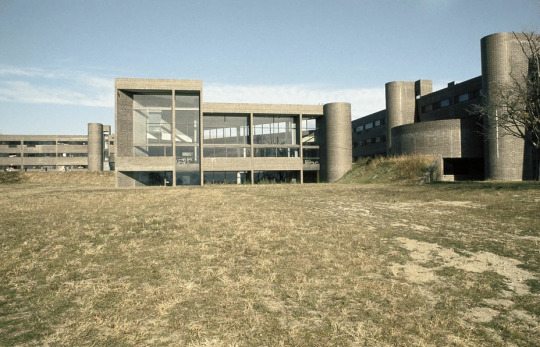

At a glance, the plan is unabashedly Beaux-Arts. Its strong longitudinal axis, the mall, with the streets running on cross axis to it, the placement of a performing arts center at the top, a gymnasium (is that symbolic?) at the bottom, all create a definite symmetry and organization of some bygone era. From a modern architect known for his adherence to quiet unassertive forms, his Harvard training under Walter Gropius and Marcel Breuer, this overriding axiality of Barnes’s plan and the grandly proportioned open spaces may come as a surprise. Nevertheless, modern architects have given in to their secret Beaux-Arts fantasies before. While considered an aberration since the modern movement substituted shifting balances for symmetry (among other things) as the chief means of ordering design, various forms of classicism and neo-Palladianism have made repeated forays onto the architectural scene. One could read the tendency in the work of Mies van der Rohe, see it full-fledged in Philip Johnson’s architecture of the 1950s, and of course always find it somewhere in the work of Louis Kahn. Even urban-planning thinking has often been (consciously or not) Beaux-Arts-oriented. As Vincent Scully recently remarked, while the Beaux Arts suffered much unpopularity in the ’40s, by the ’50s architects visiting Europe began to “discover that Beaux-Arts streets and squares made sense urbanistically.”
Barnes himself was not immune to them. A classicizing order began appearing in his houses, then gradually seeped into campus schemes in the ’50s and ’60s. So it is not unusual that Barnes should “return” to those preoccupations to create the highly dense urban situation at Purchase. He had never really gotten away from it—and neither had many of his other colleagues in the modern movement. The important question here, however, is why bringing back the Beaux Arts fails to work at Purchase. If Paris was the city of expansive vistas and grand boulevards in the 19th century, a “phantasmagoria of space to which the flaneur was addicted,” as Walter Benjamin noted, Purchase’s pedestrians seem less than ecstatic.
11 notes
·
View notes
Text
Vibin’ with Secret History where Kelsier sees GREEN plants and is momentarily stunned.
Like he’s scaling this wall, and as he does so he feels this planet. It’s Sel, but he doesn’t know that, and green being a plant color is so utterly alien to him he’s intrigued and stunned.
Scadrial is so utterly fucked up. Even Roshar, with it’s insane weather patterns and lack of an axial tilt has green plants. Green is the color of chlorophyll. It’s associated with life, hence life spren on Roshar being little green motes.
Scadrial in the first era was just red and black. What a miserable place to live. Mare collected pre-ascension lore. She knew it wasn’t the way things should be, and Kelsier was determined to bring it back.
What’s more, he succeeded by aiding Fuzz, Vin, Elend and the rest. He brought back Mare’s world.
Brown plants exist. Specifically, the shades in the final empire are possible, but these plants are adapted to low light levels.

This tradescantia is native to the southern US. It loves direct, baking sunlight, and thus uses anthocyanins to color it’s leaves to be able to tolerate the baking heat.

In the water light is refracted and reflected in such a way that light cannot penetrate, and plants have had to adapt. These aren’t truly plants; they’re a type of algae. This is Kelp. You’ll find a lot of colored plants below the water.
30 notes
·
View notes
Note
M-12 Sabretooth from Resistance: Fall of Man?
You know, the closest I ever came to playing that game was an ARMA 3 Halloween operation.
Anyways, The M-12 Sabertooth
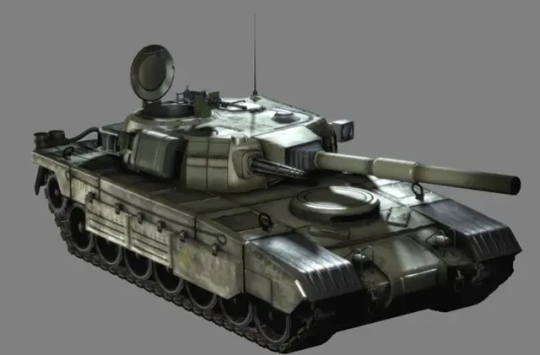
Aliens are invading Earth again, and this time they're coming hot on the heels of WWII.
So, this chassis has some pretty clear inspiration from the M1 Abrams; Running gear, side-skirts, mud-guards, even the front of the hull bear similarities to some extent.

Engine Deck is a mix of Leopard 2 fans, M60 rear grill, and even the air filters from early model Tiger 1's. Turret draws lineage from British Centurions (notably the Mk1 prototype which mounted a co-axial 20mm auto-cannon) and the add-on armor on the turret brings to mind a T-80 with ERA fitted.
This is apparently a "Light Battle Tank" so its mobility should be decent. Those road-wheels are packed in there pretty tightly.
Its also light enough to be air transported, so armor won't be stellar by any measure, but it should be sturdy enough. It's also equipped with so form of add-on armor on the turret, whether its just applique panels or ERA is unknown to me.
The Sabertooth does have some pretty sharp teeth, an 80mm rifled main gun, a .50 cal MG for the commanders hatch, and a 20mm Gatling gun mounted co-axially. That last one is a bit of an odd choice. Now, there have been a few semi-modern tanks that mounted an auto-cannon co-axially in the turret, notably the French AMX-30. But nothing to my knowledge ever mounted any caliber of Gatling gun in the turret. The main issues with this concept is space inside the turret. Its already at a premium with the main gun, armor, crew and ammunition in there; adding a bulky Gatling gun instead a normal auto-cannon is redundant since its fire-rate is probably going to be limited to below 1000 rpm so it doesn't chew through all its ammo in 6 1/2 seconds. And if that's the case, you're better off space wise going with a normal auto-cannon.
I'm not seeing very many viewports on this, or maybe they're just really small. We do atleast get a spotlight.
Driver's hatch in the hull and the commander+gunner's hatches in the turret lead me to believe it has a crew complement of 3-4.
And we have a fair array of stowage, maintenance hatches, panels, headlights and tow hooks.
FINAL SCORES
Credibility: 6/10 - r/NonCredibleDefence Approved
Coolness: 6/10 - Forest MultiCam
BONUS
Some nice AMX-30 Footage
youtube
5 notes
·
View notes
Text
VIK 10.08.3343 IE NH // TUE 12.05.2023 CE GD
It appears I was wrong on *several* levels regarding the nature of my innerworld, as well as my kintype.[1]
After much reflection, our innerworld’s genres appear to be (1) mythic historical iyashikei (albeit with Brothers Grimmesque folkloric / psychological horror elements), and (2) Arcadian Filianic media.
Similar works include “Spice and Wolf” by Isuna Hasekura, “Violet Evergarden” by Kana Akatsuki, “Little Goody Two Shoes” by AstralShift & Square Enix — *MAJOR* vibes with LGTS, by the way — and *especially* “Aristasia” by The Aristasia Community.
I (Yashi) appear to be a vixen spirit (one of the local minor geniae, to use a Filianic term) very similar to Holo from “Spice and Wolf”. We (the Orchards) are ALL spirits, as far as we know (there’s five of us). [2]
Rhiannë (aka Kyria, our godshard of Dea Filia) is a horsegirl (like those in “Uma Musume Pretty Derby” by Cygames) as opposed to a centaur, because… that’s just easier to visualize, I guess. Yasumi (if that’s still her name) is a local minor folk janya of healing. Sophie’s an attendant of Sai Candrë, which is a mythological pun — she’s an insomniac rabbitgirl, and in Japanese folklore, the moon (Sai Candrë’s sphere)’s associated with rabbits. This would also explain why Sophie looks so tired all the time: because her job requires her to work at night, yet she (Sophie) still interacts with the rest of the Orchards during daylight hours! Blueberry might be of the shiani (Filianic fae), but I’m still not quite sure. I’ll have to make it a point to ask her sooner or later.
Roughly 99% of other maids only see us Orchards as everyday Axials (ie “typical” intemorphs, of which, in this particular innerworld, there’s a bare minimum of *seven* feminine types — each based upon one or more of the myriad janyatic principles). [3] That said, this kinda-sorta works similar to Amaterasu’s divine markings in “Ōkami” by Clover Studio & Capcom — we (the Orchards) can see one another’s true forms, but most maids who aren’t spirit-beings or spiritually attuned can’t see our animal ears, tails, wings, etc.
The main area of the innerworld is Saresgrove. In older English, “sare” means “withered, rotten, dry, melancholy, etc”. Thus, “Saresgrove” more or less means “a sort of gloomy, withered wooded area”.
There are monsters of the week in the form of keres (Filianic demons) such as Anxietas, Dysphoria, etc. There’s a nearby wooded area called the Deepwoods (which is safe(ish?) for exploration), and then there’s the *Deeperwoods* (which is where all the eldritch horrors and monsters of the week lurk in the dark).
Overall, the historical era appears to be some kind of anachronism stew between c. 1400 and 1910 CE GD.
No magic in Saresgrove — Saresgrove’s very similar to the not!Europe of “Spice and Wolf” in this regard. That said, doors exist between media-worlds in the form of a phenomenon known as Sai Brighë’s Door.
〜 〜 〜 〜 〜 〜 〜 〜 〜 〜 〜 〜 〜
[1] …Now that I think of it, I might’ve been right on both kintypes all along — I’m a vixen genia, yes, but I’m *also* from an all-girl world (and, thus, an alien).
[2] That is to say, there’s five of us *for now* (as of SUC 10.25.3343 IE NH // FRI 12.22.2023 CE GD).
[3] We’d like to clarify that, while Saresgrove seems to be some form of protectorate / territory / etc. of the Queendom of Arcadia in Internalia, schizomorphs (i.e. beings from not-all-female worlds) are more than welcome. For instance, Kyria Rhiannë seems to have greenlighted Flocke [LGTS] for entry to Saresgrove, if / when we find out what happens in Kieferberg. Additionally, there’s at least *one* anthropomorph.
#foxgirl#spiritkin#inner world#plurality#fictionkin#holohearted#femmekin#aethyrcadian filianism#aethyrcadia
5 notes
·
View notes
Text
Ensayo de Tema 2. Medici: Masters of Florence (2016)
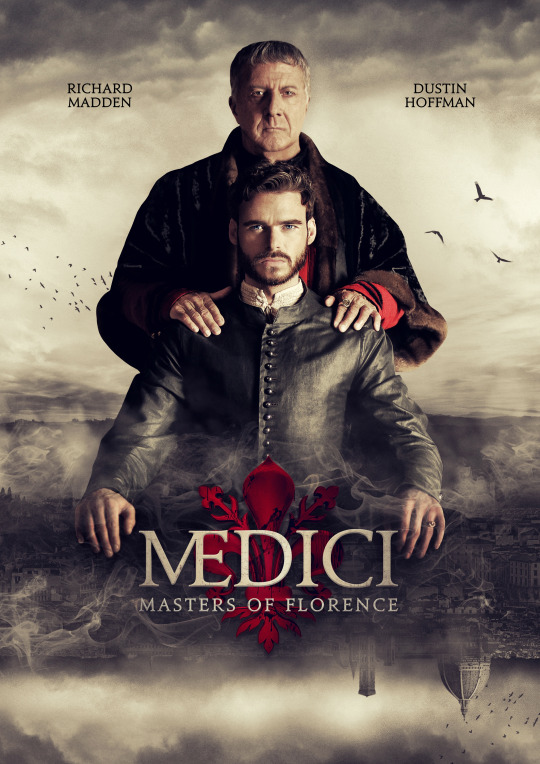
La serie de televisión Medici: Masters of Florence es un drama histórico basado en la familia Medici de la Florencia del siglo XV, en los inicios y auge del movimiento renacentista.
Desde un punto de vista cultural, la serie ha tomado sus libertades con respecto a la precisión histórica. Sin embargo, narrativamente, ha podido acercar a la familia Medici y el Renacimiento italiano a una audiencia moderna tomando en cuenta rasgos o puntos claves de contextualización histórica. La serie destaca la importancia de la arquitectura en el ascenso al poder de la familia Medici, ya que fueron mecenas de las artes, donde sus encargos no sólo tenían propósitos de afición o contemplación, sino pensados para fines políticos, sociales y económicos.
En el inicio de la serie, se muestra como la familia Medici tuvo sus comienzos en la industia del comercio de la lana hasta convertirse en uno de los bancos más grandes de Europa (con conexiones poderosas sobre todo en la zona occidental del continente), logrando un alto status social y político. Tomando en cuenta los crecientes juegos de poder en el contexto de ciudades-estados dominadas por la nobleza, los Medici alcanzan ese privilegio por medio del desarrollo de su industria banquera desde el cimiento.
A lo largo de esta primera temporada, se muestra uno de los principios fundamentales de la familia Medici: la percepción es poder, y la arquitectura juega un rol fundamental para dicha percepción social y política.

Cosimo, el heredero de la familia luego de la muerte de su padre Giovanni, era un hombre idealista con un pasado en las artes. En el contexto de la muerte de su progenitor y de la guerra de Milán y Florencia, él utiliza la arquitectura como su medio principal para consolidar la influencia y poder de su familia en la ciudad, teniendo la opinión pública a su favor. Esto lo logra con la construcción del domo de la Cattedrale di Santa Maria del Fiore, la catedral de Florencia que tenía décadas paralizada en su construcción, debido a la alta dificultad (o casi imposibilidad en la época) de terminar la cúpula de grandes dimensiones (mayores que las del Panteón romano).

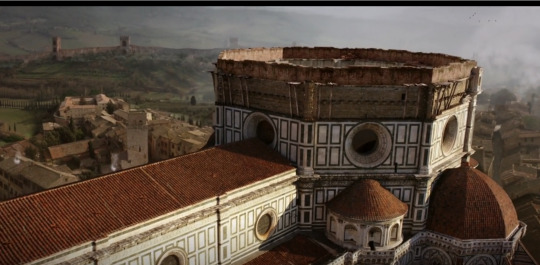


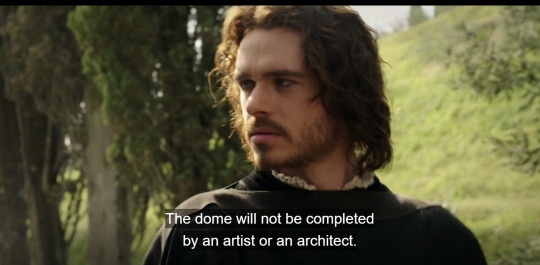
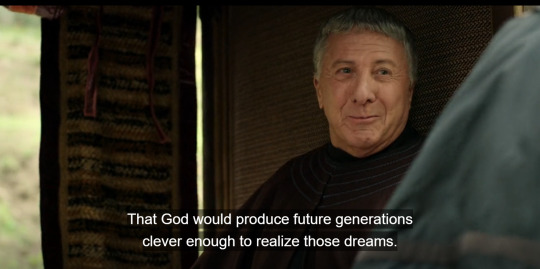
En el aspecto contextual artístico, se pueden observar los fondos de las escenas ricos en estilo y estética, resaltando los rasgos paleocristianos, románicos y góticos tardíos transicionando a nuevas formas durante el Renacimiento.
Desde los frescos basados en el antiguo estilo romano (usado exhaustivamente en el arte paleocristiano), las columnas de órdenes griegos que brindan simetría axial y orden, las catedrales de planta de cruz latina, hasta los palacios de patio central y cortile, la serie se encarga de exponer y pasear a la audiencia cinematográficamente por todos los elementos que componían el panorama artístico y arquitectónico durante el Renacimiento, donde el presente estaba en constante diálogo con el pasado.

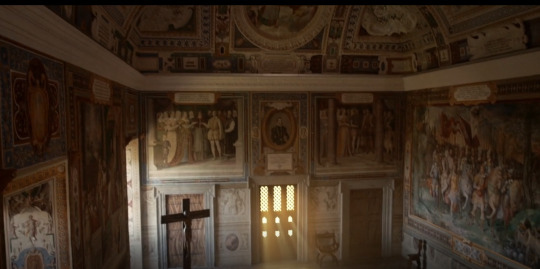
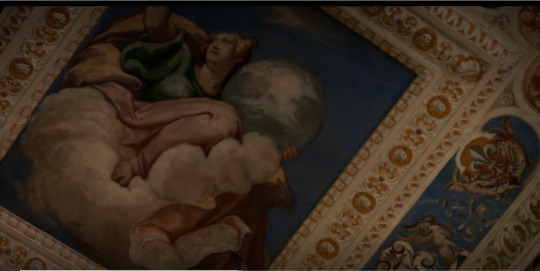

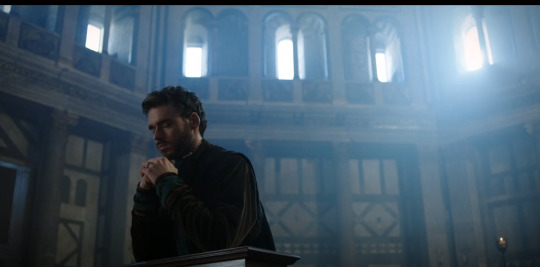
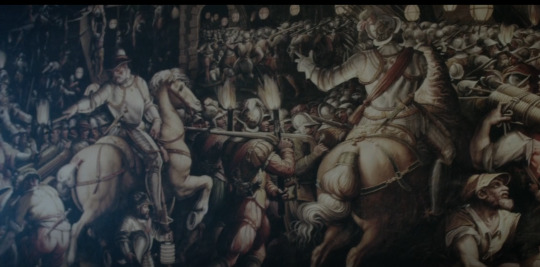
Se resalta el debate dicotómico que se estaba produciendo vivamente durante la época entre el pensamiento predominante del medioevo sobre la guerra como medio de superviviencia, y el nuevo pensamiento de cuestionar los órdenes establecidos y los métodos de resolución de conflictos para los intereses propios. Se destaca reiteradamente que siempre se puede tomar una decisión de seguir con las antiguas tradiciones disfuncionales, o aventuararse a una filosofía que permita una mejor sociedad y existencia para uno mismo, incluso en la estrechez de la situación. Esta idea también se representa a lo largo de la serie entre los métodos de Giovanni como patriarca de la familia y los métodos de Cosimo como heredero (buscando tomar libertades que no eran usuales en los manejos políticos del padre).
Continuando con el desarrollo en el segundo y tercer episodio, la guerra con Milán no estaba dando buenos resultados y la economía de Florencia estaba en ruinas (impuestos altos, escasez de flujo de dinero, cierre a importaciones, destrucción de la base de empleo e inversión, etc.). Cosimo financia al visionario orfebre y arquitecto Filippo Brunelleschi para que construya una cúpula para la catedral de Santa Maria del Fiore, generando así empleo y migración interna, mientras los Albizzi seguían explotando a la población con miras de seguir manteniendo el estado de guerra, por lo que Cosimo negocia un acuerdo entre Lucca y el duque de Milán para la paz por medio de su contacto, Francesco Sforza.
Se resalta como Cosimo se volvió un estatega político y económico tanto de sus recursos como de los recursos disponibles de aquellos a su alrededor, con tal de lograr sus intereses y objetivos sin ensunciarse las manos en el acto, siempre y cuando beneficie la imagen de la familia Medici. En la serie en general, se ve cómo los poderosos utilizan a la población civil y su fervor/lealtad religiosa o política para sus propios intereses.

En cuanto a la construcción del domo de la catedral, Filippo Brunelleschi fue contratado para la obra. Se presenta como él, en un principio, no era considerado en su círculo social debido a sus actividades de orfebre. Sin embargo, Brunelleschi es presentado en la serie como el visionario que fue, ideando un diseño basado en el cálculo matemático estructural para poder construir la cúpula.
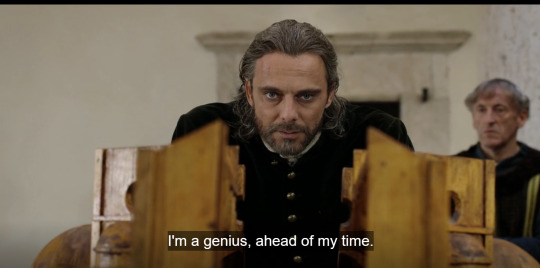
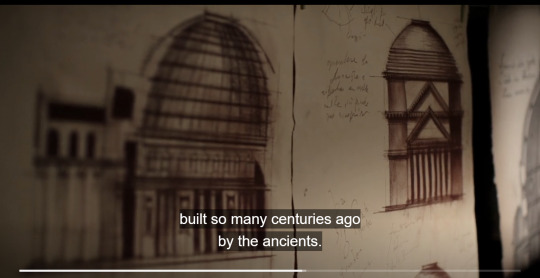

Explica que se realizará sin sistema de andamiaje; en cambio, será construida en el aire, siendo sostenida por dos domos en vez de uno. El domo interior funcionará como soporte para el domo exterior. Los primeros 46 pies serían construidos en piedra, luego se utilizarían materiales más livianos, como por ejemplo el bloque de ladrillo, el cual sería colocado en forma de enlosado en espina de pez (conocido como herringbone pattern en inglés), de manera que los bloques sirvan de soporte unos a otros.
Como buen renacentista, se basó en los principios clásicos de orden, centralidad y distribución de peso encontrados específicamente en el Panteón de Roma, el cual sería su "musa" para esta obra.

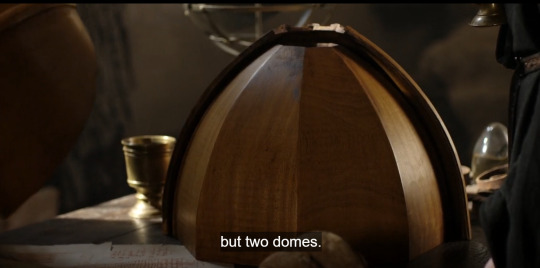

Estas situaciones que se han descrito hasta ahora revelan que una de las nociones fundamentales de Cosimo durante la serie para cumplir sus objetivos es el de aprovechar (o ingeniar) oportunidades en los escenarios complicados o precarios. En estos episodios, la arquitectura fue protagonista de su jugada económica, política y social para dar propaganda a su familia, generar empleo (y, por ende, ingresos) para la ciudad con la construcción del domo de la catedral, dar una peor imagen a la guerra de la que ya tenía entre la opinión pública florentina, llevando a perjudicar indirectamente a su rival, Rinaldo Albizzi. Además, Cosimo utlizó los fondos de los diezmos de los fieles religosos destinados al papa para la elaboración de la construcción, justificando incluso los fines religiosos de tal emprendimiento.
Durante la peste negra, se incentivó a continuar la obra, esta vez convirtiendo a la catedral en un hospicio para los víctimas de la peste, una vez más, favoreciendo la imagen de los Medici ante la opinión pública.
Con esta estrategia magna de Cosimo, la gente no estaría agradecida con los Albizzi por hacer la guerra o incentivar levantamientos políticos que generan inestabilidad social, sino con los Medici por haber alimentado a sus familias y desarrollado la economía en tiempos de crisis, fortaleciendo el favor de la población, el cual, guiándose por los principios de "El Príncipe" de Maquiavelo en los capítulos 2 y 3 (Nicolás Maquiavelo, "El Príncipe". 1532, Italia), es fundamental para mantenerse en el poder y lograr control sobre ellos por medio de su propia voluntad.
Continuando con la línea de pensamiento maquiavélica, es bueno para el gobernante ideal ser amado por su población por los actos que hace para manternerla contenta, y, al mismo tiempo, es bueno ser temido por esa misma población cuando se muestra lo que ocurre si alguien busca alterar el orden y el poder del gobernante. Desde mi punto de vista personal, esas nociones de teoría socio-política/ciencias políticas están bien logradas en la serie.

En cuanto al contexto religioso, se reflejan las prácticas comunes de la iglesia de la época, donde la curia católico-romana del periodo renacentista no se caracterizaba precisamente por ser "fieles religiosos movidos por la fe". Parafraseando al teólogo argentino Lucas Magnin (Magnin, L., "Las Cinco Solas: ¿Por qué nunca me contaron esto?"), era un tiempo donde el continente pasó de ser de papas y pontífices a príncipes. El papa y el alto clero tenían mayor interés en ser mecenas (y la percepción y beneficio social que ello conlleva) que ser pastores. Era un tiempo donde ser papa o cardenal daba un estatus y poder cercanos (o, incluso, hasta igual o mayor) al de un príncipe o gobernante de la nobleza. Mientras más conexiones (y capital) hubiese para subir la intrincada escalera jerárquica de la iglesia de ese tiempo, mejor, puesto que aquellos que se introducían a las altas esferas del clero veían realizadas sus expectativas de riqueza.
De acuerdo a los testimonios de la época de creyentes descontentos con la institución (como Pedro Valdo, Girolamo Savonarola, Jan Hus, John Wycliffe, William Tyndale o el propio Martín Lutero con sus 95 tesis), las intenciones de estas personas en el establishment religioso eran dejar huellas de poder de la mano de las grandes mentes artísticas e intelectuales del Renacimiento; los sacerdotes de las parroquias que buscaban guiar genuinamente en la fe a los feligreses contaban con muy poca instrucción teológica, pastoral y filosófica, sin contar con el apoyo necesario de la institución.
Esta era la cristiandad que se estaba viviendo, donde ser cristiano era más un asunto cultural que uno de convicción, situación que empezaría a ver su ocaso desde el Renacimiento en la sociedad europea gracias al auge la modernidad, llegando a lo que hoy en día en el Occidente posmoderno se conoce como post-cristianismo.
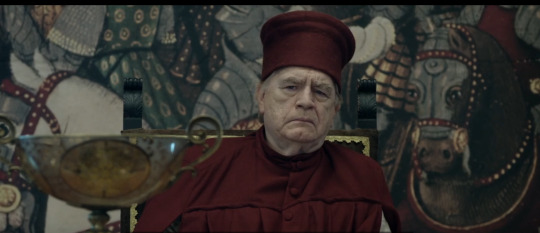

Todo este contexto religioso que se muestra en la serie de Medici: Masters of Florence es lo que sentaría las bases posteriormente para la Reforma protestante.
En conclusión, la serie no es un recuento histórico exacto (lo cual no es el objetivo principal, no es lo que busca la serie, ni debe ser la expectativa de uno mismo como espectador), sino una aproximación y representación histórica adaptada para una audiencia moderna, donde la contextualización, estilos y narrativa está bien lograda. Desde la escenografía, la actuación, el reparto y el guión hasta el desarrollo de la trama y la concientización de la audiencia sobre las situaciones de la época, en general, son elementos que logran su cometido en acercar a los espectadores al contexto renacentista, la crisis ideológica de transición que se estaba viviendo y del uso de la arquitectura y las artes para la consolidación del poder e influencia, por medio de una de las familias que tuvo mejor uso de esos recursos cuando se presentó la oportunidad: los Medici.
#lonuevodenuevo#arquitectura#architecture#historia#historia2#renaissance#renacimiento#cultura#medici#cosimo de medici#filippo brunelleschi#italia#firenze#essay
2 notes
·
View notes
Text

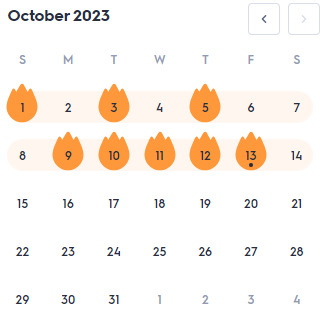
13 October 2023
I had my first "Celebration of Knowledge" (exam) today! I felt good about it until I got to a spot where I had to find the square of something -- I thought "uh-oh. I don't think I memorized the equation correctly because there's no calculators and I have to square a number" -- but then I heard some calculator clicking buttons and took a big sigh of relief. I didn't have a calculator, so I had to multiply it by hand :')
The pic on the right is of my "Quizlet streak" that I didn't know was a thing. I've been trying to study bones at least 30 minutes a day. I finished memorizing the appendicular skeleton, now it's time for the axial skeleton!
Happy Era's Tour Concert Movie release day to all that celebrate!
Now listening to: Miss Americana and the Heartbreak Prince
#studyspo#studyblr#pharmblr#a&p#anatomy and physiology#quizlet#taylurking#taylor swift#eras tour#swv#swv:oc#studywithvictory#Spotify
5 notes
·
View notes
Note
question though:
If the Christian God is real what does that make you think of the Bible
a pretty solid collection of those of his doings which spoke to the Jewish people during the Hellenistic period, a new age of marvels very like our own
i have this very strong feeling of there being a 500 year long "present time" in antiquity as being pretty much the period between the Transmigration to Babylon and the end of the Apostolic Age. I think this is informed mostly by it being Bible Times, rather than any sort of Axial Age of Axial Virtue. The most presentlike feeling I have is in the Augustan era, and I am convinced by Crossan that his absence makes him among the most conspicuous characters in the New Testament.
9 notes
·
View notes
Text
Hallazgo inesperado: La cafeína ralentiza la progresión de la miopía en niños

Getty Images (iStock).
28 agosto 2022
Mientras la investigación para el tratamiento de determinadas enfermedades se produce en las esferas de los grandes virus o del mal de males (el cáncer), parece que se producen ciertos avances en la investigación de los efectos beneficiosos de determinados alimentos. Hoy la cafeína:
________________________________________________________
El efecto inesperado de la cafeína: ralentiza la progresión de la miopía en niños
20MINUTOS NOTICIA26.08.2022 - 10:24H
Un subproducto de la cafeína se usa en Dinamarca para tratar la miopía infantil.
La cafeína, probablemente la sustancia psicoactiva más consumida en todo el mundo, tiene muchas propiedades de lo más fascinantes. Es estimulante, diurética y vasoconstrictora. En general, se considera que su uso moderado puede resultar beneficioso en muchas áreas de la salud (eso sí, hay que señalar que su consumo también puede acarrear ciertos problemas, especialmente en cantidades excesivas y diariamente).
Con todo, aún es mucho lo que nos queda por aprender sobre ella. En esta línea, un equipo internacional de científicos ha encontrado que un metabolito (es decir, un producto del procesamiento de una sustancia por el organismo) de la cafeína parece ralentizar la progresión de la miopía en niños.
Un tratamiento en uso en Dinamarca desde 2009
Así se desprende de un artículo publicado en la revista científica British Journal of Ophtalmology, en el que se explica que este metabolito se viene usando para tratar la miopía infantil en Dinamarca desde al menos 2009, pero que hasta el momento no se había evaluado en estudios a largo plazo.
Gracias a esto, los autores del presente trabajo pudieron tomar los datos de 711 niños (356 chicas y 355 chicos) tratados de miopía en una clínica ocular danesa entre junio del año 2.000 y enero del 2021. Dentro de la muestra, 624 habían recibido tratamiento con 7-MX en dosis de hasta 1.200mg diarios.
La miopía se produce cuando el ojo crece demasiado en el eje frontal, con lo que toma una forma alargada. Por ello, para evaluar la eficacia del 7-MX, se fijaron en las mediciones axiales de los ojos de los niños.
Aparentemente eficaz y sin efectos secundarios
Por este método, encontraron que los niños que habían recibido el metabolito de la cafeína mostraban una progresión más lenta de la miopía que aquellos que no lo habían recibido, y que esa ralentización era más acusada conforme aumentaba la dosis.10 técnicas para dormir rápido sin tener sueño
Otro punto importante es que, durante el periodo que duró el seguimiento de estos niños, ninguno de ellos reportó ningún efecto secundario significativo, lo que indica que se trataría de un tratamiento seguro.
Aun así, es importante aclarar varios puntos. El primero es que el estudio es observacional, y por tanto no puede establecer una relación causa-efecto válida entre la ingesta de 7-MX y la ralentización de la progresión de la miopía; esto solo puede hacerse mediante un ensayo aleatorizado.
La segunda cuestión es que no pudieron ajustar los resultados a diversos factores que podrían influir, como la genética, el tiempo pasado en exteriores, el tiempo pasado trabajando o la etnia.
Finalmente, se debe tener en cuenta que, aunque nuestro organismo produzca 7-MX al procesar la cafeína, el efecto del metabolito no tiene por qué replicarse simplemente por la ingesta de bebidas cafeinadas, siendo relevantes otros factores como la dosis o el método de administración.
Referencias
Trier K, Cui D, Ribel-Madsen S, et al. Oral administration of caffeine metabolite 7-methylxanthine is associated with slowed myopia progression in Danish children. British Journal of Ophthalmology Published Online First: 22 August 2022. doi: 10.1136/bjo-2021-320920
1 note
·
View note
Text
Historia antigua
En las webs para aprender historia gratis puedes saber sobre la Historia Antigua se define comúnmente como el periodo comprendido entre el comienzo de la humanidad y el final del Imperio Romano de Occidente, alrededor del año 500 d.C.. Incluye todas las épocas de la prehistoria, es decir, la Edad de Bronce, la Edad de Hierro y el periodo Axial.
Para el estudio de la historia antigua, la arqueología ha desempeñado un enorme papel en la comprensión de las primeras civilizaciones, desde la excavación del ejército de terracota del primer emperador Qin en la antigua China hasta la exploración de las pirámides egipcias.
Aunque la mayor parte de nuestro conocimiento de la Antigüedad se basa en los relatos de los historiadores de la Antigüedad (Heródoto, Tucídides, Arriano, Plutarco, Polibio, Sima Qian, Salustio, Livio, Josefo Flavio, Suetonio y Tácito), esos escritos se produjeron a menudo décadas, si no siglos, después de los acontecimientos que describían y siempre hay que tener en cuenta otros factores.
El estudio de los textos antiguos y los trabajos arqueológicos que han confirmado o no esos escritos han sido la piedra angular del estudio de la Historia Antigua.
Historia Medieval
Con una duración aproximada de 1.000 años, la mayoría de los historiadores la sitúan en el año 476, con la caída del Imperio Romano de Occidente. La fecha convencional con la que los historiadores italianos ponen fin a la Edad Media es 1492: el año del descubrimiento de América.
Por supuesto, este periodo no es el mismo para todas las civilizaciones; por ejemplo, en Escandinavia, la Historia Antigua no terminó hasta el año 793, lo que comúnmente se conoce como el inicio de la Era Vikinga.
En la historia de Japón, el periodo medieval abarca desde el comienzo del periodo Nara en 709 hasta el final del periodo Sengoku y la unificación del país en 1605.
Ese periodo estuvo marcado por la expansión geográfica de la civilización:
China se estableció como centro de influencia y poder en Asia y Oriente,
la expansión del Islam y las conquistas musulmanas en Oriente Próximo y la Península Ibérica.
El poder de la Iglesia cristiana del Imperio Romano siguió creciendo en el norte y el este de Europa
1 note
·
View note
Text
Bret Devereaux pointed out in one of his recent posts that, while the model was slightly different, the republican Roman constitution was still, basically, the constitution of a city, not an empire. Not a particularly big city, either Ergo, everything had to be done in person. Ergo, terms of one year. Etc. And that seems important to me to understand why, even if Graeber and Wengrow are right and there was a huge diversity of modes of social and political organization in humanity's distant past, why axial age states frequently converged on some kind of despotism as they got bit. There is a problem of scale here, which is related to the issue of bureaucracy and communications.
I mean, also one of basic politics: why do the people of Smyrna want to be part of a larger empire, whether Greek or Roman or Persian? They probably don't depend enough on trade in that era to make the early modern model of large states as basically common trade areas useful to them. Local elites would prefer to retain all of the excess they can capture rather than sharing it with a distant king. And the local peasants aren't too keen on taxes going up. So the only people interested in building large states are empires, whose elites want to increase the amount of wealth they have, and conquest is cheaper (and much more productive, by huge margins) than local investment.
(Small states occasionally form as confederations against larger foes--this seems to be how the Northern Kingdom of Israel formed, as a confederation of tribes in the hill country trying to oppose outside conquest. But these confederations are limited by the extent of common cultural and political interests; they may transition later into empire-building states, though.)
So if you want to build a big state in the axial age, the number of models you have to look to for how to do it is going to be pretty limited. And you're probably not going to converge on anything like democracy, even for regional elites, because you don't want people democratically deciding to dissolve the empire. That's not what empires are for. But even accounting for that, the Roman model seems really deeply unsuited for that the Romans were trying to do in the last couple centuries BCE. Rome was getting too big, Italian politics were too complex, and the early imperial conquests were on too large a scale to run a burgeoning empire on city-state institutions. And idk, maybe everybody was too jealous of their slice of the power pie, of their particular relationships of patronage and authority, to consider yielding any of that to a formal bureaucracy. But instead they got an Emperor, and an awkward system of succession prone to crisis and civil war!
39 notes
·
View notes
Text
Exploring the Wonders of Globes of the World: A Journey Through Geography and Culture
Globes of the world are not just decorative pieces; they are windows to the world, encapsulating the beauty and diversity of our planet Earth. These spherical representations serve as invaluable educational tools, providing insights into geography, history, and culture. From ancient times to the modern era, globes have been cherished for their ability to spark curiosity and foster a deeper understanding of the world we inhabit. Join us on a captivating journey as we explore the wonders of globes of the world and unravel the stories they hold.
Historical Significance: The history of globes can be traced back to ancient civilizations, where early cartographers and astronomers crafted rudimentary spherical models to depict the Earth and celestial bodies. The Greeks and Romans were among the first to create terrestrial globes, using them for navigation, exploration, and astronomical studies. However, it was during the Age of Exploration in the 15th and 16th centuries that globes gained widespread popularity, as explorers and scholars sought to map the newly discovered lands and seas.
During the Renaissance period, advancements in cartography and printing technology led to the production of more accurate and detailed globes. Renowned cartographers such as Gerardus Mercator and Martin Behaim created elaborate globes that showcased the latest geographical discoveries and navigational routes. These globes became prized possessions among royalty, scholars, and merchants, symbolizing the spirit of exploration and discovery that characterized the Renaissance era.
Educational Tools: In the modern era, globes continue to play a vital role in education, offering students a tangible representation of the world's geography and topography. From classrooms to libraries, globes serve as interactive learning tools, allowing students to explore continents, oceans, and countries with ease. By rotating the globe and studying its features, students gain a deeper understanding of geographical concepts such as latitude, longitude, and the Earth's axial tilt.
Globes also provide valuable context for historical events, cultural phenomena, and geopolitical relationships. By examining the distribution of landmasses and the location of countries, students can better comprehend the factors that shape global politics, economics, and social dynamics. Additionally, globes facilitate discussions about environmental issues, climate patterns, and natural disasters, fostering environmental awareness and stewardship among future generations.
Cultural and Artistic Expressions: Beyond their educational utility, globes of the world are celebrated for their aesthetic appeal and artistic craftsmanship. Throughout history, artisans and craftsmen have adorned globes with intricate designs, decorative motifs, and ornate stands, transforming them into exquisite works of art. From Renaissance-era celestial globes embellished with elaborate constellations to contemporary designer globes featuring minimalist designs, these spherical masterpieces showcase the creativity and ingenuity of human expression.
Globes also serve as symbols of cultural identity and national pride, reflecting the rich heritage and diversity of different regions and civilizations. In many cultures, globes are cherished as heirlooms, passed down through generations as symbols of knowledge, wisdom, and exploration. Whether displayed in museums, libraries, or private collections, globes of the world continue to inspire awe and admiration, transcending time and space with their timeless beauty and universal appeal.
Technological Advancements: In recent years, technological advancements have revolutionized the design and functionality of globes, ushering in a new era of interactive and digital exploration. Modern globes are equipped with advanced features such as LED lighting, interactive touchscreens, and augmented reality capabilities, allowing users to explore the world in immersive and engaging ways. These innovative globes provide real-time updates on geographical data, weather patterns, and geopolitical developments, offering a dynamic and interactive learning experience for users of all ages.
Furthermore, digital globes enable users to customize their viewing experience, allowing them to zoom in on specific regions, overlay thematic maps, and access additional information about landmarks, cultures, and historical events. Whether used for educational purposes, leisure, or professional research, digital globes offer a wealth of opportunities for exploration and discovery in the digital age.
Conclusion: Globes of the world stand as timeless symbols of human curiosity, exploration, and imagination. From ancient civilizations to the modern era, globes have played a pivotal role in shaping our understanding of the Earth and its inhabitants. Whether crafted from traditional materials such as wood and paper or equipped with cutting-edge technology, globes continue to inspire wonder and fascination, serving as gateways to the wonders of our planet and the vastness of the cosmos. As we embark on our journey through geography and culture, let us celebrate the enduring legacy of globes of the world and the boundless possibilities they represent.
0 notes
Text
Revolutionizing Operating Rooms: Surgical Booms Market Sets New Trends and Achieves Unprecedented Growth
The global Surgical Booms Market is experiencing a paradigm shift, witnessing remarkable trends and achieving unprecedented growth, according to the latest market analysis. As healthcare facilities continue to evolve, the demand for advanced and efficient surgical equipment is on the rise, propelling the Surgical Booms Market into a new era of innovation and expansion.
Key Trends Redefining the Surgical Booms Market:
Integration of Advanced Technologies: Surgical booms are increasingly incorporating cutting-edge technologies, such as smart connectivity, advanced imaging capabilities, and robotic assistance. These technological integrations enhance surgical precision, streamline workflow, and contribute to better patient outcomes.
Customization for Specialized Applications: The market is witnessing a surge in demand for customized surgical booms designed for specific medical disciplines. From neurosurgery to cardiovascular procedures, manufacturers are focusing on tailoring their products to meet the unique requirements of different specialties, thereby enhancing the overall efficiency of healthcare delivery.
Rising Adoption of Hybrid Operating Rooms: With a growing emphasis on minimally invasive procedures, hybrid operating rooms are becoming more prevalent. Surgical booms play a pivotal role in these environments by providing space optimization, ergonomic design, and seamless integration of medical equipment, fostering a conducive environment for complex surgeries.
Gate Full Report:https://www.econmarketresearch.com/industry-report/surgical-booms-market/
Key Segments Driving Market Growth:
Hospitals and Surgical Centers: The largest segment in the market, hospitals and surgical centers are investing significantly in state-of-the-art surgical booms to improve surgical workflows and enhance patient care.
Ambulatory Surgical Centers (ASCs): ASCs are witnessing a surge in demand for compact and versatile surgical booms, catering to the growing trend of outpatient surgeries. The cost-effectiveness and flexibility offered by these centers are driving the adoption of advanced surgical equipment.
Specialty Clinics: The increasing focus on specialized medical services has led to a rise in the number of specialty clinics adopting surgical booms customized for their unique requirements.
Other Reports:
HVAC Chillers Market Growth
Cognitive Robotics Market
Industrial IoT Display Market
Edible Offal Market
Potato and Yam Derivatives Market
Marine Application Market Opportunities
Wind Power Parks Market Revenue
Aluminum Slug Market Development
Floor Adhesive Market Sales
Pet Fitness Care Market Technology
Axial Flux Motor Market Drivers
Audio and Video Equipment Market Types
Self Stabilizing Spoon Market Challenges
Solar Backsheet Films Market Outlook
Marine Sensors Market Analysis
Dry Shipping Container Market Segmentation
Blood Stream Infection Testing Market Size
Ethyl Vanillin Market Growth
Prebiotic Fiber Market Future
Solar Watch Market Trends
Industrial and Commercial Floor Scrubbers Market Analysis
Electro-Mechanical Brake Market Share
Fiber-Reinforced Plastics Recycling Market Segmentation
Closed Cell Foam Market Drivers
Perfume Ingredient Chemicals Market Technology
Bucket Wheel Excavator Market Revenue
Female Fragrance Market Sales
Yard Crane Market Outlook
Fuel Cells In Aerospace And Defense Market Size
SOC Containers Market Analysis
Digital Brain Health Market Growth
0 notes
Text
Timeless Elegance: Exploring the Legacy of Old Omega Watches
The allure of old Omega watches transcends mere timekeeping, encapsulating a rich legacy that spans over a century. As collectors and enthusiasts delve into the world of vintage timepieces, the old Omega watches emerge as timeless symbols of elegance, innovation, and a commitment to excellence.
A Glimpse into Horological History:
Old Omega watches serve as windows into the captivating history of watchmaking. Each timepiece carries a narrative of Omega's evolution, from its early days as a pioneering brand to its pivotal role in shaping the standards of accuracy and performance in the world of watches. Collectors cherish these timepieces not just for their beauty but for the stories they tell.
Iconic Designs:
The design language of old Omega watches is iconic and enduring. From the classic simplicity of the Omega Constellation to the distinctive features of the Omega Speedmaster, these timepieces exhibit a design prowess that has stood the test of time. The vintage aesthetics, intricate details, and timeless elegance make them coveted pieces for collectors who appreciate the fusion of art and engineering.
Precision and Innovation:
Omega's commitment to precision and innovation is evident in its old watches. Many of these timepieces were pioneers in their era, featuring groundbreaking technologies such as the co-axial escapement and the use of innovative materials. The legacy of precision set by old Omega watches continues to influence the brand's contemporary offerings.
Collectible Rarity:
The scarcity of certain models adds an element of exclusivity to old Omega watches. Collectors are drawn to the hunt for rare vintage pieces, whether it be a limited edition release, a discontinued model, or a timepiece with a unique historical significance. The thrill of uncovering these rare gems enhances the allure of collecting vintage Omega watches.
Craftsmanship Beyond Time:
Craftsmanship lies at the heart of old Omega watches. Meticulously crafted movements, intricate dials, and high-quality materials showcase the brand's dedication to producing timepieces that transcend generations. The enduring craftsmanship is not just a testament to Omega's legacy but also a guarantee of durability and longevity.
Investment Value:
Vintage Omega watches often appreciate in value, making them not only cherished possessions but also sound investments. The rarity, condition, and historical significance of these timepieces contribute to their desirability among collectors and investors alike, adding a financial dimension to the joy of owning an old Omega watch.
Timeless Elegance in the Modern Era:
The influence of old Omega watches extends beyond the vintage market. Modern Omega timepieces often pay homage to the designs and innovations of their predecessors, creating a seamless blend of timeless elegance and contemporary technology. The legacy of old Omega watches continues to shape the brand's identity, ensuring that the spirit of craftsmanship endures in the watches of today.
0 notes